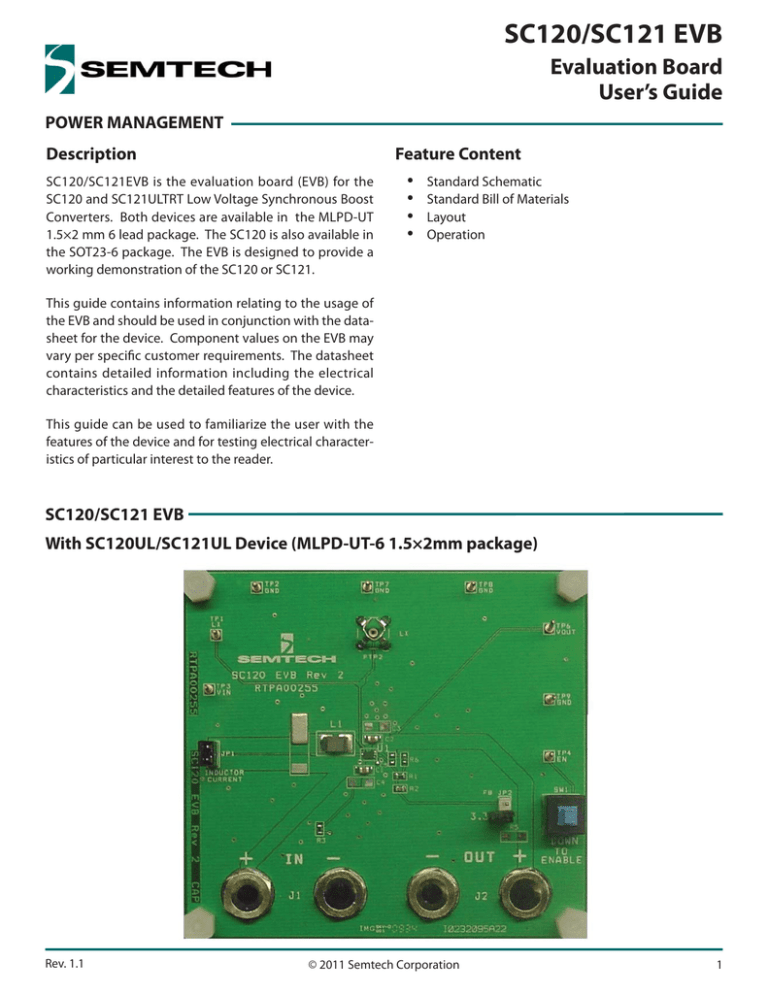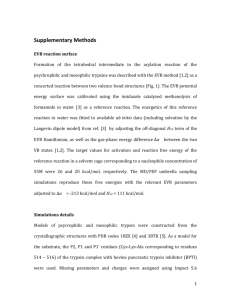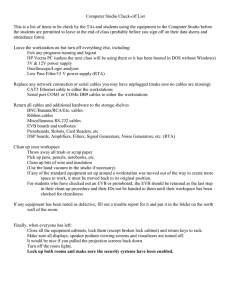
SC120/SC121 EVB
Evaluation Board
User’s Guide
POWER MANAGEMENT
Description
Feature Content
SC120/SC121EVB is the evaluation board (EVB) for the
SC120 and SC121ULTRT Low Voltage Synchronous Boost
Converters. Both devices are available in the MLPD-UT
1.5×2 mm 6 lead package. The SC120 is also available in
the SOT23-6 package. The EVB is designed to provide a
working demonstration of the SC120 or SC121.
•
•
•
•
Standard Schematic
Standard Bill of Materials
Layout
Operation
This guide contains information relating to the usage of
the EVB and should be used in conjunction with the datasheet for the device. Component values on the EVB may
vary per specific customer requirements. The datasheet
contains detailed information including the electrical
characteristics and the detailed features of the device.
This guide can be used to familiarize the user with the
features of the device and for testing electrical characteristics of particular interest to the reader.
SC120/SC121 EVB
With SC120UL/SC121UL Device (MLPD-UT-6 1.5×2mm package)
Rev. 1.1
© 2011 Semtech Corporation
1
SC120/SC121 EVB
SC120SK EVB
With SC120SK Device (SOT23-6 package)
Notice: All referenced brands, product names, service names and trademarks are the property of their respective owners.
2
SC120/SC121 EVB
Schematic Drawings
SC120/SC121 EVB
R4
PTP2
0
JP1
J_LOOP
1
TP3
VIN
3
R3
TP7
GND
100kΩ
SW1
TP4
EN
TP2
GND
5 4 2 1
4
C1
2
C4
No
Pop
R5
TP6
VOUT
L1
2
U1
J1
VIN
TP1
LX
J2
VOUT
4.7μH
JP2 - ENL
SC120UL/
SC121UL
LX
IN
EN
GND
10μF 10μF
OUT
T
FB
1
No
pop
6
5
PAD
Down 6 3 Up
C5
C3
C2
10μF
10μF
1
R6
0Ω
R1
499kΩ
R2
1MΩ
2
TP8 TP9
GND GND
SW PUSHBUTTON
DPDT
SC120SK EVB
R4
PTP2
0
JP1
J_LOOP
1
TP3
VIN
R3
J1
VIN
TP7
GND
1
TP4
EN
TP2
GND
100kΩ
SW1
5 4 2 1
Down 6 3 Up
6
C1
C4
10μF 10μF
2
TP6
VOUT
L1
2
U1
TP1
LX
No
Pop
R5
J2
VOUT
4.7μH
SC120SK
IN
EN
GND
LX
OUT
FB
JP2 - ENL
3
C5
No
pop
4
5
C3
C2
10μF
10μF
1
R6
0Ω
R1
499kΩ
R2
1MΩ
2
TP8 TP9
GND GND
SW PUSHBUTTON
DPDT
3
SC120/SC121 EVB
Standard Bill of Materials
Reference
Value
Footprint
Hardware Notes
R1
499kΩ
0603
R2
1MΩ
0603
R3
100kΩ
0603
Pull-up resistor from EN to VIN
R4
0
0603
Shorting bar is provided offset, with only one terminal connected. Install shorting bar to bypass inductor current sense loop.
R5
No Pop
2512
Not populated, optional load resistor
R6
0
0603
R6 is connected in series with R1. R6 permits using two resistors
in series for a large (effective) value of R1 (see datasheet).
SW1
DPDT
TP1
Test point
0.040
LX pin voltage sense
TP3
Test point
0.040
IN pin voltage sense
TP4
Test point
0.040
EN pin voltage sense
TP5
Test point
0.040
FB pin voltage sense
TP6
Test point
0.040
OUT pin voltage sense
TP2, TP7, TP8, TP9
Test point
0.040
Ground
L1
4.7μH
7 x 4 (mm)
SC120UL or
SC121UL
1.5 x 2 (mm)
SC120SK
2.8 x 2.9 (mm)
C1, C2
22μF
0805
Capacitor, X5R dielectric, 6.3V rating, Murata GRM21BR60J226M
C3, C4
No Pop
1206
Not populated
C5
No Pop
0603
Feedback capacitor — optional
JP1
Berg-2pin
2-100
Inductor current sense loop connections — external loop connector provided
JP2
Berg-2pin
2-100
Short = 3.3V, open = resistor programmed
PTP2
SLX
J1
Banana Jack
Input
J2
Banana Jack
Output
Valid for 1.8V output.
Push-button switch, down position enables output.
Inductor, Murata LQH43MN4R7K03
Semtech integrated circuit — MLPD-UT-6 package
U1
Semtech integrated circuit — SOT23-6 package
PRB-TP-5031
Note:
Component values on the EVB may vary per specific customer requirements.
4
SC120/SC121 EVB
Layout Drawings — SC120/SC121 EVB
Top layer metal and silkscreen
5
SC120/SC121 EVB
Layout Drawings — SC120/SC121 EVB
Bottom layer metal (top-side view) with top-side silkscreen shown for reference
6
SC120/SC121 EVB
Layout Drawings — SC120SK EVB
Top layer metal and silkscreen
7
SC120/SC121 EVB
Layout Drawings — SC120SK EVB
Bottom layer metal (top-side view) with top-side silkscreen shown for reference
8
SC120/SC121 EVB
Operation
The SC120/SC121 EVB provides configuration options for
any SC120 or SC121 application. The following describes
the standard configuration. If an EVB is requested with a
non-standard configuration, some of the standard values
or configurations will differ from this description.
The output voltage can be set to 3.3V using internal programming by installing a jumper on JP1. Any other
voltage from 1.8V to 5.0V can be programmed using resistors R1, R2, R6, and capacitor C5. R1 and R2 are the
programming resistors described in the datasheet, there
designated R1 and R2, respectively. The EVB is provided
with R1 = 499kΩ and R2 = 1MΩ, for an output voltage of
1.8V. R6 is in series with R1, and is useful for obtaining
high values for R1 as the sum of R1 and R6, or for dividing
R1 into two resistors to mitigate environmental concerns if
a large value of R1 is desired. The EVB is provided with
R6 = 0Ω. C5 is also described in the datasheet, there designated C FB. It is used to improve the PSAVE ripple
amplitude if needed, as described in the datasheet. The
EVB is provided with C5 removed.
The input supply is connected using banana jacks J1. The
IN sense test point (TP3) is provided for input monitoring,
or for Kelvin sense feedback to the input supply. The
output load is connected using banana jacks J2. The OUT
sense test point (TP6) provides a sense connection to the
output capacitor. Two sets of capacitor pads are provided
for both the input and output capacitors to permit devices
of different package sizes, either 0805 or 1206.
The enable pin is pulled up to IN with a 100kΩ resistor, R3.
The pushbutton switch connects EN to ground to disable
the SC120/SC121 when the button is in the up position.
When the pushbutton is in the down position, the switch
is open, EN is pulled high, and the SC120/SC121 is
enabled.
The inductor is connected from IN to LX by one of three
methods. A jumper can be installed on JP1 to complete
the inductor current path from the input supply. A wire
loop can be connected across JP1 for use with a current
probe to monitor inductor current. R4 is in parallel with
JP1. A shorting bar is included soldered to only one R4
pad. Replace the shorting bar across both R4 pads to
bypass the current sense loop. A Tektronix scope probe
connection point (PTP2) is provided to monitor the LX pin
voltage. Alternatively, LX pin voltage can be monitored
using TP1.
R5 is an unpopulated resistor pad that is provided for connection of a fixed load resistor directly on the board.
9
SC120/SC121 EVB
© Semtech 2011
All rights reserved. Reproduction in whole or in part is prohibited without the prior written consent of the copyright
owner. The information presented in this document does not form part of any quotation or contract, is believed to be
accurate and reliable and may be changed without notice. No liability will be accepted by the publisher for any consequence of its use. Publication thereof does not convey nor imply any license under patent or other industrial or intellectual
property rights. Semtech assumes no responsibility or liability whatsoever for any failure or unexpected operation resulting from misuse, neglect improper installation, repair or improper handling or unusual physical or electrical stress
including, but not limited to, exposure to parameters beyond the specified maximum ratings or operation outside the
specified range.
SEMTECH PRODUCTS ARE NOT DESIGNED, INTENDED, AUTHORIZED OR WARRANTED TO BE SUITABLE FOR USE IN LIFESUPPORT APPLICATIONS, DEVICES OR SYSTEMS OR OTHER CRITICAL APPLICATIONS. INCLUSION OF SEMTECH PRODUCTS
IN SUCH APPLICATIONS IS UNDERSTOOD TO BE UNDERTAKEN SOLELY AT THE CUSTOMER’S OWN RISK. Should a customer
purchase or use Semtech products for any such unauthorized application, the customer shall indemnify and hold
Semtech and its officers, employees, subsidiaries, affiliates, and distributors harmless against all claims, costs damages
and attorney fees which could arise.
Notice: All referenced brands, product names, service names and trademarks are the property of their respective
owners.
Contact Information
Semtech Corporation
Power Management Products Division
200 Flynn Road, Camarillo, CA 93012
Phone: (805) 498-2111 Fax: (805) 498-3804
www.semtech.com
10








